I participated in the 67th Annual Meeting of the Japanese Society of Applied Entomology & Zoology (March 13-15, 2023 @ Setsunan University).
In addition to presenting the research results of the year, I had a great time with various people.
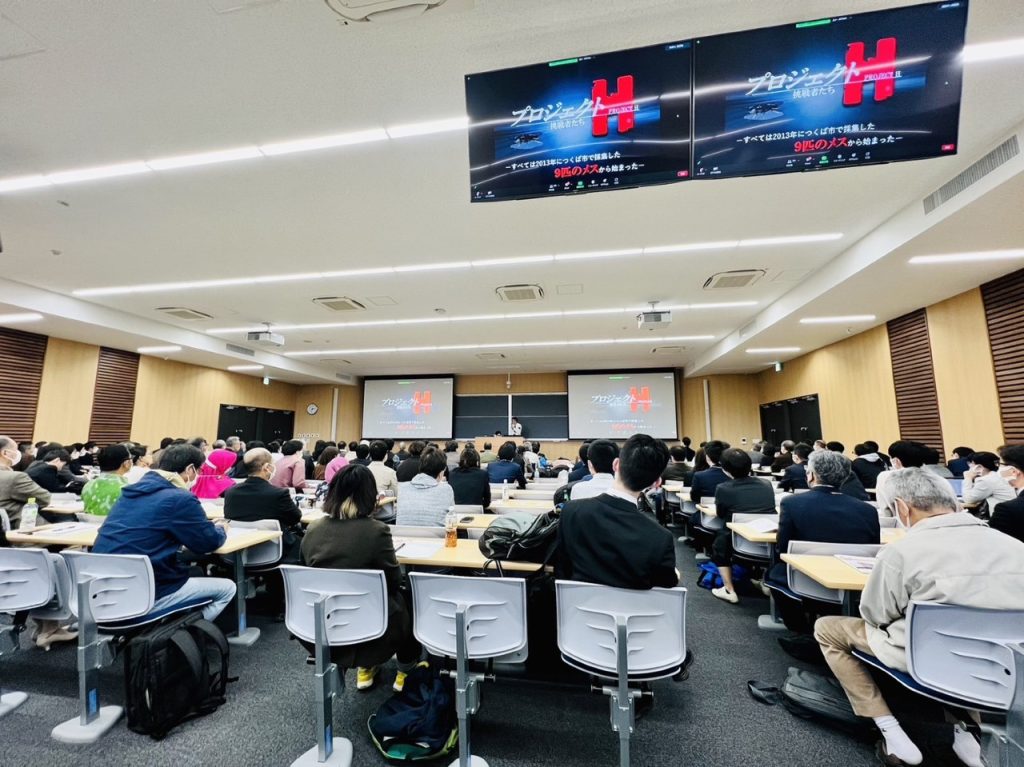
Public Symposium “Moonshot Aims for Insect Utilization and Pest Control in 2050”.
“Is it really possible to turn flies into fodder?” Masami Shimoda
Oral Presentations
「A study of egg-laying preference in Drosophila prolongata」Jyunichi Akutsu
「Behavior annotation using object detection algorithms」Qu Yicun(Takashi Matsuo)
「Growth of black soldier fly larvae is unaffected by suppression of gut microbiome」Rina Fukunaga
ポスター発表
“A study on the economics of black soldier fly business” Hiroto Oki
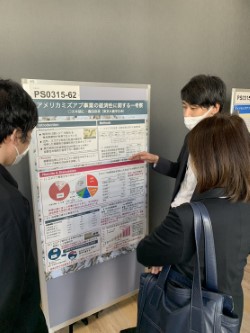
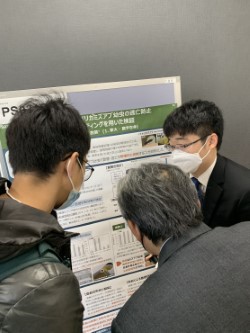
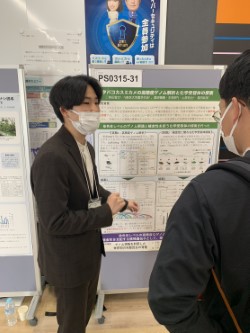
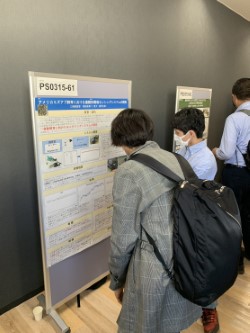
「RNAiによって生じたフェモラータオオモモブトハムシの構造色変化」香月雅子ら
「ネギアザミウマの視覚認知:赤ネットはどうして防除効果が高いのか?」德嶋賀彰ら
「コーヒー抽出かすを利用したアメリカミズアブ幼虫大量飼育法の開発」藤田弥佳ら
「アミノ酸トランスポーターの阻害によるアメリカミズアブ幼虫のアミノ酸含量の増加」劉家銘ら
「紫色LEDライトを用いたヒメカメノコテントウの誘導」伊藤健司ら
「紫色LEDライトを用いたトバテンの定着増強効果」村田篤志ら
<Details>
The 67th Annual Meeting of the Japanese Society of Applied Entomology & Zoology (March 13-15, 2023 @ Setsunan University)
“A study on the economics of black soldier fly business” Hiroto Oki
〇 Hiroto Oki・Masami Shimoda (Agri Life Sci, Univ Tokyo)
Approximately 1.3 billion tons of food products are disposed of worldwide every year, and there is a growing need for recycling technology with less environmental impact. In recent years, a treatment method using the corrosive insect black soldier fly (Hermetia illucens) has been attracting attention for its contribution to resource recycling of waste, but in practice it faces the problem that it is not easy to ensure profitability. Therefore, we created business models with different monthly treatment volumes (10, 50, and 300 tons) and clarified the amount of larval production and compost production per volume of treated residue for existing technologies. The profitability of the BSF treatment business was also considered by calculating the facility area required for each treatment volume and estimating the production cost and the value required for the assumed sales channels. As a result, it was shown that the amount of larvae produced per treated residue was approximately 71.9 kg/t, and the amount of compost produced was approximately 660 kg/t. Furthermore, the labor cost for the majority of the production cost was estimated to be approximately $3,000/t. In addition, labor costs accounted for the majority of the production costs, and the automation of the larval collection and egg-laying process, in particular, was expected to bring about significant economies of scale. Therefore, there is still room for cost reduction in the production system of the BSF treatment method, and the introduction of automated technology that does not require human labor is expected to promote the expansion of production scale and sales channels.
“Prevention of black soldier fly larval escape by wall protrusions: verification using 3D printing” Jang Sunjae
〇 Jang Sunjae・Masami Shimoda (Agri Life Sci, Univ Tokyo)
The larvae of the black soldier fly Hermetia illucens (BSF) have excellent substance conversion ability and are expected to be used for food residue treatment, livestock feed production, and other applications. However, the migratory diffusion of BSF larvae is active, and when their body surface is wet, they climb vertical surfaces and escape through the smallest gaps in rearing containers. Therefore, the objective of this study was to develop a surface structure that inhibits the climbing wall and escape of BSF larvae. The methods used were as follows: (1) Commercially available Velcro tape, Teflon tape, and sandpaper were attached to the inner wall of a glass beaker to compare their effectiveness in inhibiting climbing walls. Each container was filled with artificial feed and 20 larvae (7, 10, and 20 days old), and the percentage of larvae remaining (%) in the container was determined after 3 days. Experiment 2) Next, a tape-like structure with conical protrusions on its surface (hereafter referred to as “protrusive structure”) was devised. We designed three different spacing of protrusions (0.5, 1.5, and 2.5 mm) and fabricated them with a 3D printer together with a structure without protrusions (control) and compared them as in Experiment 1). The results showed that the average survival rate was significantly higher in the containers treated with the protruding structures than in the control, especially at 10 and 20 days of age, and the larval survival rate in the containers with protrusions was over 80%. These results indicate that the application of projecting structures with appropriate placement intervals to rearing containers can provide a high escape inhibition effect.
“High-quality whole genome analysis and chemoreceptor discovery in the zoophytophagous stink bug” Tomofumi Shibata
〇 Tomofumi Shibata (Agri Life Sci, Univ Tokyo)・Takuya Uehara(NARO)・Masami Shimoda (Agri Life Sci, Univ Tokyo)
Nesidiocoris tenuis, the zoophatophagous stink bug, is a species of natural enemy insect that preys on micro pests such as thrips. This species has a higher predatory ability than other natural enemy insects and is expected to be widely used as a biological pesticide. However, this species is zoophatophagous, and in some plants, it has both a vegetative nature that allows it to reproduce only on plant parts and a carnivorous nature that allows it to prey on pests. Therefore, when the population density increases, it can also damage agricultural crops. In this study, we conducted a whole genome analysis with higher quality than in the previous year to search for genes characteristic of this omnivorous species, and also focused on taste genes among functional genes. In the whole genome analysis, nanopore sequencing coverage was increased, Hi-C analysis was performed, and functional annotation using EnTAP and GeMoMa was also conducted. In the gene search, we compared the homology of taste genes with four closely related species with different feeding habits. As a result, we were able to obtain a genome sequence with much improved continuity and functional annotation in the whole genome analysis. In the gene search, a phylogenetic tree based on homology revealed genes that formed clades in vegetivorous and carnivorous species. These results will greatly contribute to the search for more useful genes of this species and to the solution of its problems.
アメリカミズアブ飼育における連続的環境センシングシステムの開発
〇 Soougo Nishioka・Masami Shimoda (Agri Life Sci, Univ Tokyo)
The black soldier fly Hermetia illucens (BSF) has recently attracted much attention from the perspective of organic waste management. However, the supply of knowledge and technology for stable mass rearing and automated rearing is not sufficient. In this study, for the purpose of constructing a sensing system for automated BSF rearing, we used a RaspberryPi4 microcontroller to operate environmental sensors (temperature, humidity, and illumination) in the rearing room and physicochemical sensors (temperature, moisture content, and pH) in the culture medium, and constructed a monitoring system to enable remote data collection. We confirmed that the environmental and physicochemical sensors (except for moisture content) functioned stably during small-scale rearing in 500-ml beakers, and attempted continuous measurements in beakers containing larvae (experimental area) and in beakers without larvae (control area). As a result, while neither temperature nor pH fluctuated significantly in the control beaker, the pH shifted to basic in the experimental beaker, and a temperature increase was observed at the same time. These results indicate that this sensing system can be used for real-time acquisition of rearing/medium environment information, and can be connected to a feeding robot to develop an unmanned automatic rearing system in the future.
Growth of black soldier fly larvae is unaffected by suppression of gut microbiome
〇Rina Fukunaga・Masami Shimoda (Agri Life Sci, Univ Tokyo)
Black soldier fly (BSF), Hermetia illucens, is the basis of a new method for organic waste recycling. BSF larva’s strong digestive capacity is thought to derive from its gut microbiome (GM). To examine the potential symbiotic relationship between BSF and its GM, we compared the growth of germ-free larvae with that of larvae with germs. Germ-free larvae were prepared by sterilizing eggs with 1% sodium hypochlorite solution and feeding the hatched larvae autoclaved artificial diet. We also prepared germ-free larvae using antibiotics. For the control ‘with-germs’ treatment, we inoculated food with a small amount of frass obtained from the debris of normal BSF rearing. Surprisingly, germ-free larvae, including those prepared using antibiotics, grew up at the same rate as the larvae with germs. The maximum weight of germ-free larvae was 0.43g, which was comparable to that of larvae reared with germs. These results indicate that BSF larvae are not dependent on GM for their normal growth and question the role of GM in BSF’s strong digestive capacity.
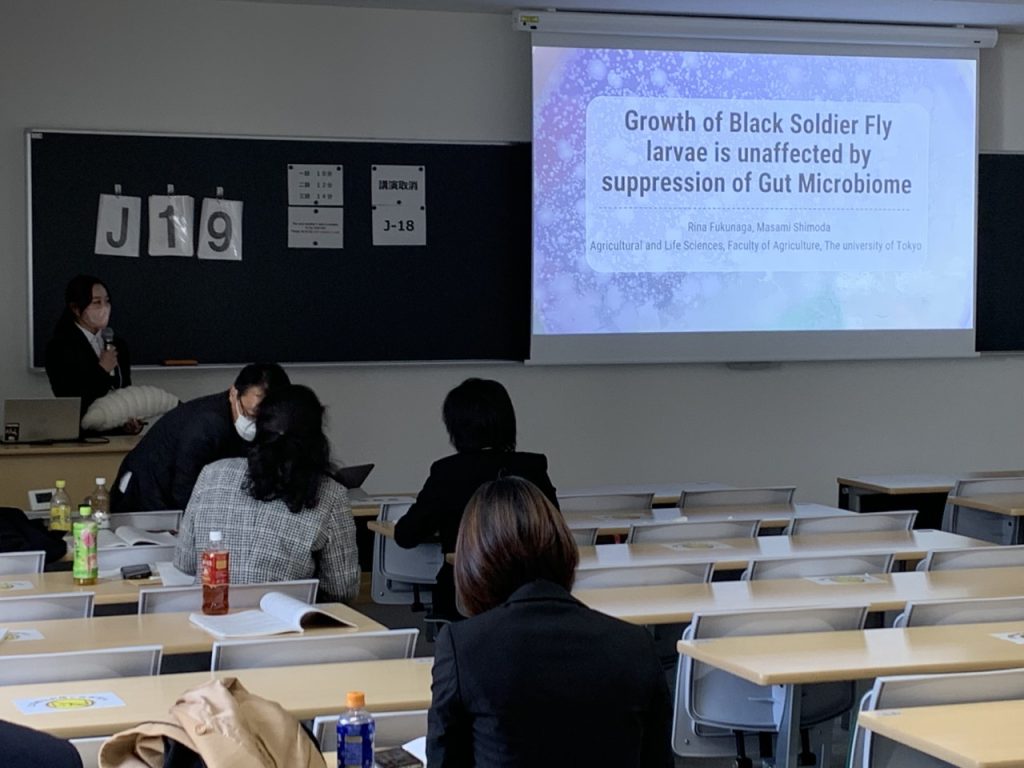
ネギアザミウマの視覚認知:赤ネットはどうして防除効果が高いのか?
◯德嶋 賀彰(千葉県松戸市)・德丸 晋虫・伊藤 俊(京都府農技セ)・
山口 照美・霜田 政美(東大・農学生命)
慣行の白色系防虫ネットの代わりに赤色系防虫ネット(赤ネット)を物理的防除法として圃場に展張することで,ネギ(德丸ら、2016)及びキャベツ(Ohya et al., 2022)へのネギアザミウマによる被害を軽減できることが報告されている.異なる色のネットに対する行動反応の違いは,ネギアザミウマがネットの光反射波長を視覚的に認識した結果として解釈できるはずである.では,赤ネットの防除効果の背後で,ネギアザミウマは一体どのような視覚情報処理を行なっているのだろうか?これを推測するために,赤ネットによる防除効果を視細胞分光感度にもとづき統計的にモデル化して分析した.その結果,緑型視細胞が強く刺激される赤色系のネット では防除効果が向上し,一方で青型視細胞が強く刺激される白色系のネット では防除効果が低下することが示唆された.このことは,本種の脳内高次ニューロンにおいて緑型視細胞と青型視細胞の各信号を差分処理していることを意味しており,本モデルを適用することで防虫ネット素材を最適化できる可能性がある.
コーヒー抽出かすを利用したアメリカミズアブ幼虫大量飼育法の開発
〇藤田弥佳1・劉 家銘1・成 耆鉉2・松井正人3・小林徹也1・霜田政美4・安田哲也1
1.農研機構 2. 神奈川県立保健福祉大学 3.清水建設株式会社 4. 東大・農学生命
アメリカミズアブHermetia illucens は食性が広く、生ゴミ、家畜糞なども摂食できる腐食性昆虫である。幼虫は栄養価に優れ、今後、畜産飼料や水産飼料などへの活用が期待されている。ミズアブの産業利用のための低コスト・省力で収量の高いミズアブ幼虫大量飼育法を開発するため、コーヒー抽出後のかすの利用に着目した。コーヒー抽出かすは現状ではほぼ産業廃棄物として扱われており、リサイクルの用途が求められている。
まずコーヒー抽出かす単独でミズアブ幼虫を飼育したところ、摂食はするものの成長が遅かった。次に、入手が容易で品質が一定な市販のパン粉をコーヒー抽出かすに混合して加水した飼料を用い、ミズアブ幼虫を終齢まで飼育した。コーヒー抽出かす:パン粉の混合重量比1:1の飼料では幼虫は十分に発育するものの、飼育期間後半に飼料の粘性が高くなり幼虫を回収しにくかった。3:1では幼虫は順調に発育し回収も問題なかった。一方、9:1までパン粉を減らすと幼虫は大きく育たなかった。コーヒー抽出かすを他の食品残渣と混合することで、ミズアブ幼虫の生産に活用できることが明らかになった。
アミノ酸トランスポーターの阻害によるアメリカミズアブ幼虫のアミノ酸含量の増加
◯劉家銘・上原拓也(農研機構)・霜田政美(東大・農学生命)
アメリカミズアブHermetia illucens (以下、ミズアブ)の幼虫はタンパク質を多く含むため、養殖魚飼料の代替タンパク質源として注目されており、養殖魚の要求に応じてアミノ酸量を増加させることが望ましい。本研究では、ミズアブ幼虫のアミノ酸排出を抑制することにより、体内にアミノ酸を過剰蓄積させることを試みた。まず、中腸(MG)とマルピーギ管(MT)のアミノ酸輸送に関わるアミノ酸トランスポーター(NATs)遺伝子を解析した。次に、MG-NATとMT-NATの輸送機能を阻害するため、幼虫体腔に二本鎖RNA(dsNATs)を注入した。結果、MG-NATを阻害した幼虫はコントロールと比べMG-NAT発現量は29%に、体重は22%に減少した。一方、MT-NATを阻害した幼虫のMT-NAT発現量は38%に、体重は45%に減少した。MG-NAT阻害幼虫のアミノ酸総量はコントロールと比べて42%減少した一方で、MT-NAT阻害幼虫のアミノ酸総量は35%増加し、アミノ酸の種類によって挙動が異なっていた。以上から、NATsを阻害してアミノ酸排出を抑制することで、ミズアブ幼虫のアミノ酸総量や動物の要求に応じたアミノ酸組成の調整が可能であると結論した。
〇伊藤健司¹・霜田政美²・杉山満隆3・小原慎司¹・手塚俊行¹ (株式会社アグリ総研¹・
東大・農学生命²・日栄インテック株式会社3)
近年、ナミヒメハナカメムシ、タバコカスミカメ、ブランコヤドリバエ、ヒメカメノコテントウなどの多くの天敵昆虫で紫色光選好性が発見されており、この選好性を利用することで害虫防除に寄与できると考えられている。そこで演者らは作物への天敵の誘導を目的とした照度センサー機能付き紫色LEDライトを開発し、茨城県取手市の鉢植えナスを多数設置したビニールハウス内でオオムギバンカーに定着させたヒメカメノコテントウを対象に効果の確認を行った。その結果、紫LEDライト非設置区では、オオムギバンカー周辺に長期間留まっていたのに対して、設置区では試験開始の翌日から紫LEDライト側への移動が確認された。
〇村田篤志1・手塚俊行2・杉山満隆3・霜田政美4(茨城県立農業大学校・園芸部1、株式会社アグリ総研2、日栄インテック株式会社3、東大・農学生4)
波長選好性の研究から、ヒメハナカメムシ・ブランコヤドリバエ・タバコカスミカメなどの天敵昆虫が405nm付近の紫色光に強く誘引されることが見出されている。本研究では、重要な天敵昆虫であるテントウムシ数種について波長選好性を調査し、飛ばないナミテントウ(商品名トバテン)に紫色光選好性を発見した。トバテンは飛べないにも関わらず、時間とともに防除すべき作物から逃走することがある。そこで、紫色LEDライトを用いることで作物への定着が強化できるかどうかを検証した。慣行農法に則ってナスを定植したビニールハウスを2棟準備した(ただし殺虫剤は不使用)。天敵温存植物として株間にスカエボラとアリッサムを植えた。ナス株に1頭ずつトバテンを放飼して、ハウス奥からポータブル紫色LEDライト(日栄インテック製)を日没後に点灯した。その結果、①無点灯(コントロール)では放飼9日目までにトバテンが全て逃亡したのに対し、②点灯区では餌のアブラムシがいないにも関わらず、16日目以降もトバテンがナス株上に残った。この結果から、紫色LEDにはトバテンの定着増強効果があり、トバテンと紫色LEDを併用することで、生物農薬で重視される害虫発生前に天敵が存在するという状況を作れる可能性が示された。
第67回 日本応用動物昆虫学会大会 小集会(令和5年3月15日、摂南大学)
世話人:安田哲也・劉家銘・霜田政美
W12応用昆虫学の新しいチャレンジ: 腐食性昆虫を使った資源循環
W12-01 ◯藤谷 泰裕1(地方独立行政法人 大阪府立環境農林水産総 合研究所) 昆虫の特性を活用した食 品・飼料利用の展望
W12-02 ◯三浦 猛1・井戸 篤史1・三浦 智恵美2 (1. 愛媛大学農学研究 科、2. 広島工業大学環境 学部) 昆虫の水産養殖への利用: 飼料原料としての
W12-03 ◯ Shih ChengJen1・Lee Yong-Yueh2 (1. National Taiwan Univ.、2. Stonbo Creative Co.) Design and Development of Automated Rearing System for Black Soldier Fly
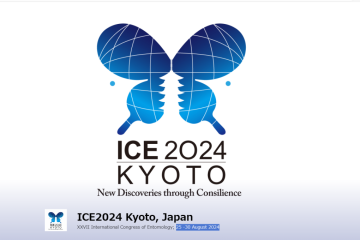
-360x240.png)
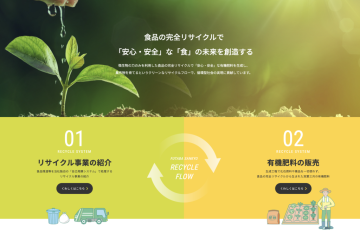
0件のコメント